Few plants can match the canna lily’s bold beauty and long history. This tropical showstopper is a lily only in name — in fact, it’s more closely related to bananas and ginger.
Once grown as food in ancient Peru, cannas, with their towering banana-like foliage and magnificent, self-cleaning flowers, shine in modern gardens.
While tender to frost, their rhizomes can be stored through winter and replanted in spring, allowing plants to live for decades.
Why Canna Lilies Thrive in Southern California
- Cannas love sunshine and warmth. SoCal’s climate is nearly perfect.
- Cannas are surprisingly drought-tolerant, an asset in a semi-arid region.
- In mild coastal and inland zones, they can bloom from late spring through fall, extending color long after many plants fade.
- Cannas can flourish in the sandy or clay-heavy soils of most Southern California yards.
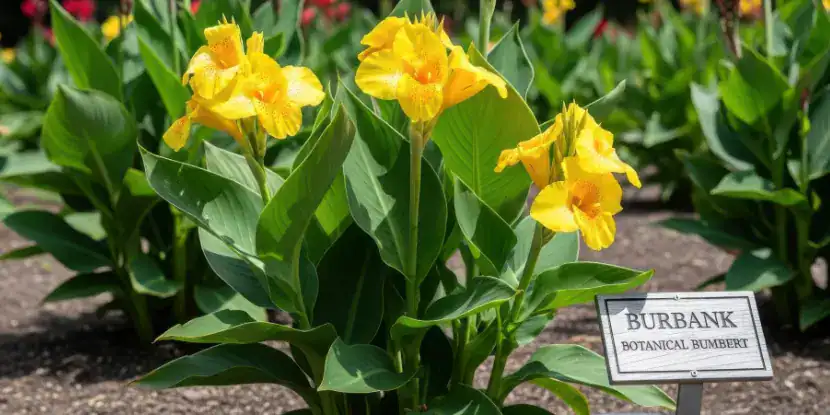
If canna plants grow in Burbank, they’ll grow in your SoCal yard, too.
Bloom Time & Duration
- First flowers appear 8–12 weeks after spring planting
- Heaviest flowering occurs from June through September
- Individual flowers last 1–3 days; continuous production maintains the display
- Flowering continues until the first frost in most SoCal areas
- Expect 4–6 months of blooms with proper care
Mature Size
- Dwarf varieties stay compact at 2–3 feet tall with smaller, delicate blooms — ideal for borders or smaller spaces.
- Standard cultivars grow 4–6 feet tall, producing lush, broad foliage and dramatic flower spikes.
- Giant hybrids can reach 8–10 feet in a single growing season, creating a jungle-like effect.
- The spread (width) is usually 1–2 feet per plant, but cannas form clumps as rhizomes multiply.
Optimal Growing Conditions
Light Requirements
- 6–8 hours of direct sunlight daily
- Eastern exposure helps plants establish strong growth
- Some protection during peak summer heat prevents stress
- Inland areas may need more shade protection than coastal regions
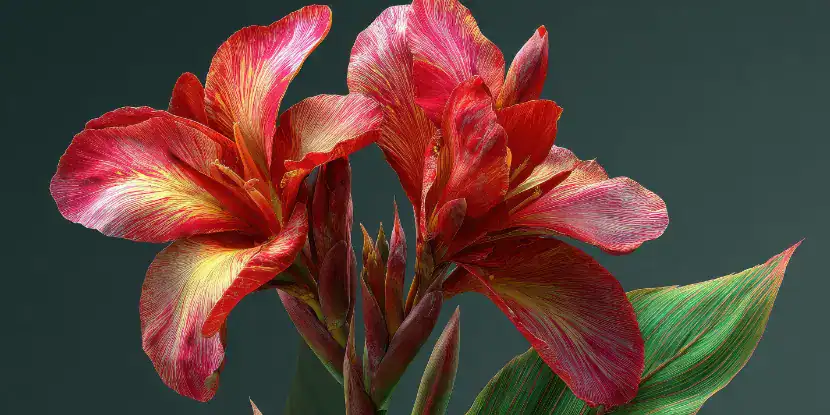
Deep red Canna × hybrida Rodigas flowers with yellow accents.
Temperature Preferences
- Temperatures between 65°F-85°F promote vigorous growth
- Consistent warmth above 70°F initiates flowering
- Temperatures below 50°F signal plants to enter dormancy
- Cover or move containers when temperatures drop below 32°F
Soil Requirements
- Well-draining sandy loam or amended clay prevents root rot
- Slightly acidic to neutral pH 6.0-7.0) supports nutrient uptake
- Compost or aged manure improves soil structure and fertility
- Soil should hold water without becoming soggy
- Till the soil 12–15 inches deep for proper root development
Steps for Planting
- Plant rhizomes after the last frost risk (March-April in most SoCal areas)
- Soak dormant rhizomes 2–4 hours before planting
- Place rhizomes 2–4 inches deep with growing points facing up
- Allow 18–24 inches between plants for proper air circulation
- Water thoroughly after planting, then maintain consistent moisture
- Apply 2–3 inches of organic mulch around plants
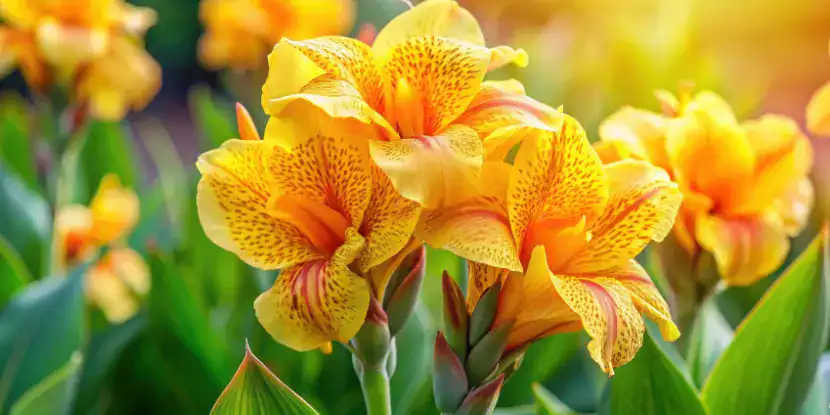
Lemon Punch canna lilies in a field.
Canna Lily Care
Watering
- Water 1–2 times weekly, soaking soil 6–8 inches deep
- Early morning watering reduces fungal disease risk
- Avoid alternating wet and dry cycles that stress plants
- Organic mulch retains soil moisture and reduces watering frequency
- Check container plants daily during hot weather
- Reduce watering significantly during winter
Fertilization
- Apply balanced fertilizer (10-10-10) when new growth appears
- Continue regular (monthly) fertilization throughout the growing season
- Compost, fish emulsion, or aged manure provide slow-release nutrition
- Extra phosphorus during bud formation enhances flower production
- Use liquid fertilizer every 2–3 weeks for potted plants
- Stop fertilizing 6–8 weeks before the expected first frost
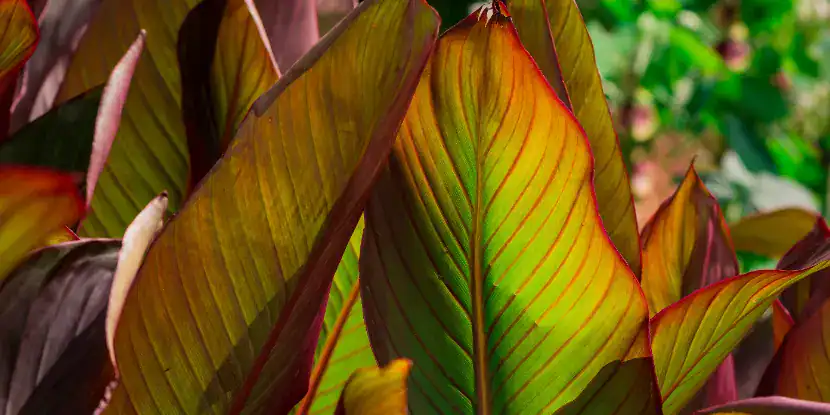
Canna foliage shows its close relationship with the banana plant.
Pest & Disease Management
Pest Problems
- Canna leaf roller: Remove affected leaves; use Bt spray for severe infestations
- Aphids: Spray with insecticidal soap or encourage beneficial insects
- Spider mites: Increase humidity; use miticide if necessary
- Snails and slugs: Place iron phosphate baits around plants
Disease Prevention
- Bacterial bud rot: Ensure good air circulation; avoid overhead watering
- Fungal leaf spots: Water at the soil level; remove affected foliage promptly
- Root rot: Improve drainage; avoid overwatering
- Virus issues: Remove infected plants immediately; control aphid vectors
Growing Canna Lilies in Pots
- Choose a large, deep pot with good drainage.
- Fill the pot with well-draining soil mix and add gravel or broken pottery at the bottom for extra drainage.
- Mix in compost or slow-release fertilizer.
- Place the rhizomes (thick, fleshy roots) horizontally on top of the soil, with about 2 inches of space between them.
- Cover the rhizomes with more soil mix, leaving the tops exposed.
- Water thoroughly until the excess water drains out from the bottom of the pot.
- Keep the soil evenly moist, but not soggy. Check every few days and water as needed.
Propagating Canna Lilies
- Divide rhizomes during the dormant season (late fall to early spring)
- Clean soil from the roots; cut with a sharp, sterile knife
- Each section needs at least one growing point (eye)
- Allow cut surfaces to dry 24–48 hours before planting
- Store divisions in slightly moist peat moss until planting
- Properly divided rhizomes have 90%+ success rates
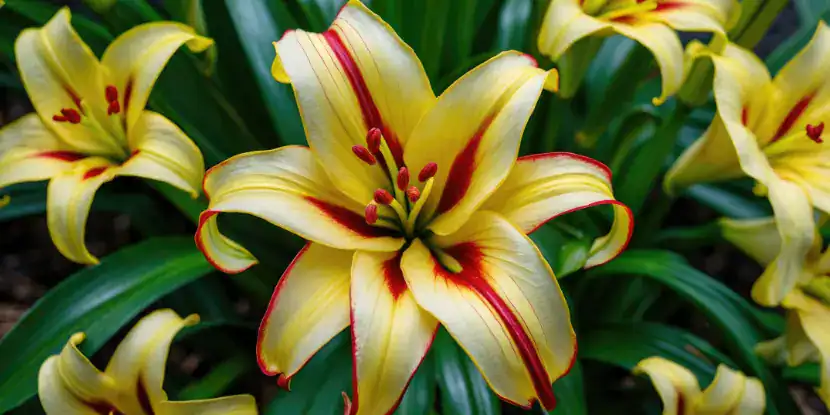
A bright yellow canna lily with burgundy stripes.
FAQs: Growing Canna Lilies
Q: When should I plant canna lily rhizomes in Southern California?
Plant after the last frost risk passes, typically March through April. Coastal areas can plant earlier than inland regions.
Q: How often do canna lilies need water during summer?
Water deeply 1–2 times weekly, adjusting for temperature and rainfall. Container plants may need daily watering during heat waves.
Q: Do canna lilies need to be dug up for winter?
In most Southern California areas, rhizomes can remain in the ground year-round. In colder inland areas, consider lifting and storing rhizomes.
Q: Why aren’t my canna lilies blooming?
Common causes include insufficient sunlight, over-fertilization with nitrogen, or immature rhizomes. Ensure 6+ hours of sun and balanced nutrition.
Q: How do I divide canna lily rhizomes?
Dig up dormant rhizomes, clean off soil, and cut sections with a sharp knife. Each division needs at least one growing point.
Q: What’s the best mulch for canna lilies?
Organic mulches like shredded bark, compost, or leaf mold work well. Apply mulch 2–3 inches thick, keeping it away from stems.
Q: Can canna lilies grow in partial shade?
While they prefer full sun, canna lilies tolerate partial shade but may produce fewer flowers and have less vibrant foliage colors.
Q: How tall do canna lilies grow in Southern California?
Height varies by variety, from dwarf types at 2–3 feet to tall varieties reaching 6–8 feet. Most common varieties reach 4–5 feet tall.

